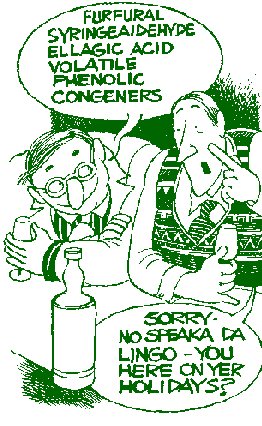The Language of WhiskyTasting
A Chemist Speaks
 In the New Year Bottlings List 1996,the thorny question of writing tasting notes was touched upon.There are two styles: tight-lipped and florid. These roughlycorrespond to the two recognised ways of approaching sensoryanalysis of any kind, viz: objective/analytical and subjective /hedonic. The whole subject arouses strong feelings, and thebattle is fought mainly within the wine trade, which has a muchmore highly developed tasting vocabulary than we do.
In the New Year Bottlings List 1996,the thorny question of writing tasting notes was touched upon.There are two styles: tight-lipped and florid. These roughlycorrespond to the two recognised ways of approaching sensoryanalysis of any kind, viz: objective/analytical and subjective /hedonic. The whole subject arouses strong feelings, and thebattle is fought mainly within the wine trade, which has a muchmore highly developed tasting vocabulary than we do.
The tight-lipped school eschews any show of emotion, metaphorand simile. Michael Broadbent, possibly the leading authority onwine tasting and author of several books on the subject,maintains that "it is ridiculous to be over-expressive aboutquite ordinary wines". He is supported by the great HughJohnson, for whom the effusions of the florid school smack of badEnglish: "Some wines do not require that sort ofimagery".
But the florid school is currently winning the day. JillyGoolden is the doyenne. For her the restrained tasting notes ofthe past are 'a fat lot of use' when it comes to getting thetaste of wine over to a wider public. She prefers to create'taste pictures' with similes drawn from everyday life.
Her co-presenter on The Food Programme, Oz Clarke,believes the tight-lipped approach is a hang-over from the dayswhen the wine trade was dominated by upper-class publicschoolboys who had been brought up to distrust any display ofemotion or enthusiasm. He is even happy that the many followersof The Food Programme 'take the piss' (his words) out of his andJilly Goolden's approach.
We openly admit to being hedonic (as in 'hedonism', the searchfor pleasure) when we describe our malt whiskies. There is muchto be enthusiastic about, and, as the Society's founder Pip Hillswrote in Scots on Scotch, the notes represent"...the joint subjectivity of our tasting panel".Nevertheless, our notes are worthless to you, dear member, ifthey bear little or no relation to what is actually there in theglass.
The Scientific Approach
Bearing this in mind, we were delighted to be able to helpColin Brown, a Manufacturing Scientist undertaking an Investigationby Analytical Chemistry of Compounds Affecting Flavour in SingleMalt Whiskies, for Napier University, Edinburgh, with thesupport of United Distillers.
He writes:
"Single malt whiskies are chemically complex and are knownto contain several hundreds of individual components (congeners)including a variety of alcohols, aldehydes, acids, esters andphenols, as well as carbonyl-, sulphur- and nitrogen-containingcompounds. Many of these contribute to the flavour of a whiskyand the relative concentrations of each are dependent uponvariations in raw materials and production methods. Consequently,each single malt whisky is discernable from any other, includingthose produced at a neighbouring distillery."
 The investigation, which iscontinuing, began by identifying the relative concentrations ofcompounds known to be extracted from the cask during maturation('cask-extractive congeners') and a group of those which arisefrom the raw materials and during production ('volatile phenoliccongeners'). It went on to make a correlation between these andthe perceived flavour of the finished product.* Four samples ofwhisky were considered, affording a regional spread. They were:Caol Ila (Islay), Scapa (Orkney), Rosebank (Lowland) and Balvenie(Speyside). "Cask-extractive congeners are of greatimportance to the overall flavour as well as the aroma and colourof the finished beverage. Whisky casks are traditionaly treatedto thermally degrade the internal surface of the cask, by firingand charring, for three major reasons:
The investigation, which iscontinuing, began by identifying the relative concentrations ofcompounds known to be extracted from the cask during maturation('cask-extractive congeners') and a group of those which arisefrom the raw materials and during production ('volatile phenoliccongeners'). It went on to make a correlation between these andthe perceived flavour of the finished product.* Four samples ofwhisky were considered, affording a regional spread. They were:Caol Ila (Islay), Scapa (Orkney), Rosebank (Lowland) and Balvenie(Speyside). "Cask-extractive congeners are of greatimportance to the overall flavour as well as the aroma and colourof the finished beverage. Whisky casks are traditionaly treatedto thermally degrade the internal surface of the cask, by firingand charring, for three major reasons:
- to generate a layer of active carbon which removes undesirable flavour substances;
- to effect the release and dissolution of flavour compounds such as vanillin during maturation;
- to yeild colour and phenolic substances which result in new flavour compounds by oxidative interactive reactions.
The results revealed that all four samples contained similarlevels of the compound furfural, which is associatedwith a general 'whisky flavour'. The unmistakably woody flavourin the Scapa sample is attributable to syringealdehyde,which is also present in Caol Ila, although the dominatingflavours of the Islay whisky are discussed later. The Balveniechromatogram reveals a high level of ellagic acid, acompound known for its pungent odour and flavour. The number andrelatively large abundance of lignin degradation productsin the Caol Ila sample would suggest that a heavily charred oakcask was used for the maturation process. The presence of 5-hydroxymethylfurfural in Caol Ila would allow the taster to expect aslightly reddish tint to the whisky.
 "Volatile phenolic congeners'primary source is from the peated malt used in whisky production.So it was not surprising to discover that the Caol Ila sample hada large number present and in concentrations greatly in excess ofthe other whiskies under investigation.
"Volatile phenolic congeners'primary source is from the peated malt used in whisky production.So it was not surprising to discover that the Caol Ila sample hada large number present and in concentrations greatly in excess ofthe other whiskies under investigation.
"The presence of phenol at 2.1 parts per million(ppm), was almost five times that for Rosebank, 20 times that forBalvenie and 200 times greater than that found in Scapa. Phenolhas a medicinal taste and therefore would be expected to bepresent in an Islay whisky. Guaiacol, known for itssmoky and phenolic flavour, was detected in concentrations of 1.2ppm in Caol Ila, but was barely detectable in the others. Furtherinvestigation showed that the levels of compounds responsible for'tarry' and 'disinfectant' flavours (m-, p- and o-cresol)were evident in the Islay sample but relatively low in Rosebank,very low in Balvenie and not detectable in Scapa. However,similar concentrations of the compound eugenol(perceived as having a flavour not dissimilar to that of cloves)were determined in both Scapa and Caol Ila. All of the whiskiesinvestigated contained varying concentrations of 4-ethylphenol and 2,5-xylenol, which co-eluted and couldnot be determined separately. Both of these substances have apowerful 'whisky' flavour."
Mr Brown concludes:
"Many other compounds were determined analytically duringthis investigation, however their individual impact on flavour isconsidered less important than their contribution to the overallflavour of each whisky. These analyses are intended to give aninsight into the complex chemistry of single malt whiskies andthe impact which each of the many hundereds of compounds has onthe characteristics of the finished product."
With respect to chemists - and subject, of course, to yourcomments - I think we will stick to hedonic descriptions!
*For those of you who understand the lingo, the compoundswere determined by the use of a 'direct-injection reversed-phaseHigh Performance Liquid Chromatographic technique (HPLC),employing gradient elution and either uv/vis (diode array)detection or fluorescence'.
Charlie Maclean
If you have comments about thissite, please contact the webmaster. All information in this site © The Scotch Malt WhiskySociety, Edinburgh, Scotland, 1997.
 In the New Year Bottlings List 1996,the thorny question of writing tasting notes was touched upon.There are two styles: tight-lipped and florid. These roughlycorrespond to the two recognised ways of approaching sensoryanalysis of any kind, viz: objective/analytical and subjective /hedonic. The whole subject arouses strong feelings, and thebattle is fought mainly within the wine trade, which has a muchmore highly developed tasting vocabulary than we do.
In the New Year Bottlings List 1996,the thorny question of writing tasting notes was touched upon.There are two styles: tight-lipped and florid. These roughlycorrespond to the two recognised ways of approaching sensoryanalysis of any kind, viz: objective/analytical and subjective /hedonic. The whole subject arouses strong feelings, and thebattle is fought mainly within the wine trade, which has a muchmore highly developed tasting vocabulary than we do.  The investigation, which iscontinuing, began by identifying the relative concentrations ofcompounds known to be extracted from the cask during maturation('cask-extractive congeners') and a group of those which arisefrom the raw materials and during production ('volatile phenoliccongeners'). It went on to make a correlation between these andthe perceived flavour of the finished product.* Four samples ofwhisky were considered, affording a regional spread. They were:Caol Ila (Islay), Scapa (Orkney), Rosebank (Lowland) and Balvenie(Speyside). "Cask-extractive congeners are of greatimportance to the overall flavour as well as the aroma and colourof the finished beverage. Whisky casks are traditionaly treatedto thermally degrade the internal surface of the cask, by firingand charring, for three major reasons:
The investigation, which iscontinuing, began by identifying the relative concentrations ofcompounds known to be extracted from the cask during maturation('cask-extractive congeners') and a group of those which arisefrom the raw materials and during production ('volatile phenoliccongeners'). It went on to make a correlation between these andthe perceived flavour of the finished product.* Four samples ofwhisky were considered, affording a regional spread. They were:Caol Ila (Islay), Scapa (Orkney), Rosebank (Lowland) and Balvenie(Speyside). "Cask-extractive congeners are of greatimportance to the overall flavour as well as the aroma and colourof the finished beverage. Whisky casks are traditionaly treatedto thermally degrade the internal surface of the cask, by firingand charring, for three major reasons:  "Volatile phenolic congeners'primary source is from the peated malt used in whisky production.So it was not surprising to discover that the Caol Ila sample hada large number present and in concentrations greatly in excess ofthe other whiskies under investigation.
"Volatile phenolic congeners'primary source is from the peated malt used in whisky production.So it was not surprising to discover that the Caol Ila sample hada large number present and in concentrations greatly in excess ofthe other whiskies under investigation.